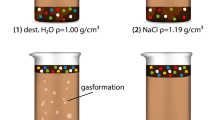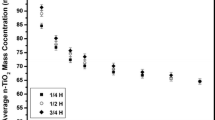Abstract
In the recent half century, numerous methods have been developed to assess ecological toxicity. However, the presence of solid-particle turbidity sometimes causes such tests to end with questionable results. Many researchers focused on controlling this arbitrary turbidity effect when using the Microtox® solid-phase toxicity system, but there is not yet a standard method. In this study, we examined four solid-phase sample test methods recommended in the Microtox® manual, or proposed from the literature, and compared the existing methods with our proposed method (centrifuged basic solid-phase test, c-BSPT). Four existing methods use the following strategies to control turbid particles: complete separation of liquid and solid using 0.45-μm filtration before contacting solid samples and bacteria, natural settlement, moderate separation of large particles using coarser pore size filtration, and exclusion of light loss in the toxicity calculation caused by turbidity after full disturbance of samples. Our proposed method uses moderate centrifugation to separate out the heavier soil particles from the lighter bacteria after direct contact between them. Among the solid-phase methods tested, in which the bacteria and solid particles were in direct contact (i.e., the three existing methods and the newly proposed one, c-BSPT), no single method could be recommended as optimal for samples over a range of turbidity. Instead, a simple screening strategy for selecting a sample-dependent solid-phase test method was suggested, depending on the turbidity of the solid suspension. The results of this study highlight the importance of considering solid particles, and the necessity for optimal selection of test method to reduce errors in the measurement of solid-phase toxicity.






Similar content being viewed by others
References
Ashworth, J., Nijenhuis, E., Glowacka, B., Tran, L., & Schenk-Watt, L. (2010). Turbidity and color correction in the Microtox™ bioassay. The Open Environmental Pollution and Toxicology Journal, 2, 1–7.
Azur Environmental. (1998). Microtox® acute toxicity solid-phase test, Carlsbad, CA, USA.
Benton, M. J., Malott, M. L., Knight, S. S., Cooper, C. M., & Benson, W. H. (1995). Influence of sediment composition on apparent toxicity in a solid-phase test using bioluminescent bacteria. Environmental Toxicology and Chemistry, 14, 411–414.
Brouwer, H., & Murphy, T. (1995). Volatile sulfides and their toxicity in freshwater sediments. Environmental Toxicology and Chemistry, 14, 203–208.
Brouwer, H., Murphy, T., & McArdle, L. (1990). A sediment-contact bioassay with Photobacterium phosphoreum. Environmental Toxicology and Chemistry, 9, 1353–1358.
Bulich, A. A., Greene, M. W., & Underwood, S. R. (1992). Measurement of soil and sediment toxicity to bioluminescence bacteria when in direct contact for a fixed time period. Water Environmental Federation 65th Annual Conference and Exposition, (pp 53–63).
Burga Perez, K. F., Charlatchka, R., & Ferard, J. F. (2013). Assessment of the LuminoTox leachate phase assay as a complement to the LuminoTox solid phase assay: effect of fine particles in natural sediments. Chemosphere, 90(3), 1310–1315.
Burga-Perez, K. F., Charlatchka, R., Sahli, L., & Ferard, J. F. (2012). New methodological improvements in the Microtox® solid phase assay. Chemosphere, 86(1), 105–110.
Campisi, T., Abbondanzi, F., Casado-Martinez, C., del Valls, T. A., Guerra, R., & Iacondini, A. (2005). Effect of sediment turbidity and color on light output measurement for Microtox® Basic Solid-Phase Test. Chemosphere, 60, 9–15.
Dalzell, D. J. B., Alte, S., Aspichueta, E., de la Sota, A., Etxebarria, J., Gutierrez, M., Hoffmann, C. C., Sales, D., Obst, U., & Christofi, N. (2002). A comparison of five rapid direct toxicity assessment methods to determine toxicity of pollutants to activated sludge. Chemosphere, 47, 535–545.
Dombroski, E. C., Gaudet, I. D., & Florence, L. Z. (1996). A comparison of techniques used to extract solid samples prior to acute toxicity analysis using the Microtox test. Environmental Toxicology and Water Quality, 11, 121–128.
Harkey, G. A., & Young, T. M. (2000). Effect of soil contaminant extraction method in determining toxicity using the Microtox® assay. Environmental Toxicology and Chemistry, 19, 276–282.
Indiana Department of Transportation Office of Materials Management: recycled foundry sand toxicity test ITM No.215-08 T. (2008).
Jho, E. H., Im, J., Yang Kim, Y.-J., & Nam, K. (2015). Changes in soil toxicity by phosphate-aided soil washing: effect of soil characteristics, chemical forms of arsenic, and cations in washing solutions. Chemosphere, 119, 1399–1405.
Jung, H. B., Park, J. G., Moon, S. H., Ryu, T. K., Kim, S. J., Bae, C. H., & Hwang, I. Y. (2001). A study for testing conditions of Microtox® toxicity test to the quality of sediment in domestic rivers. Korean Journal of Environmental Toxicology, 16, 143–151.
Keddy, C. J., Greene, J. C., & Bonnell, M. A. (1995). Review of whole-organism bioassays: soil, freshwater sediment, and freshwater assessment in Canada. Ecotoxicology and Environmental Safety, 30, 221–251.
Kovats, N., Refaey, M., Varanka, B., Reich, K., Ferincz, A., & Acs, A. (2012). Comparison of conventional and Vibrio fischeri bioassays for the assessment of municipal wastewater toxicity. Environmental Engineering and Management Journal, 11(11), 2073–2076.
Lappalainen, J., Juvonen, R., Vaajasaari, K., & Karp, M. (1999). A new flash method for measuring the toxicity of solid and colored samples. Chemosphere, 38, 1069–1083.
Lappalainen, J., Juvonen, R., Nurmi, J., & Karp, M. (2001). Automated color correction method for Vibrio fischeri toxicity test. Comparison of standard and kinetic assays. Chemosphere, 45, 635–641.
Loureiro, S., Ferreira, A. L. G., Soares, A. M. V. M., & Nogueira, A. J. A. (2005). Evaluation of the toxicity of two soils from Jales Mine (Portugal) using aquatic bioassays. Chemosphere, 61, 168–177.
Ma, X. Y., Wang, X. C., Ngo, H. H., Guo, W., Wu, M. N., & Wang, N. (2014). Bioassay based luminescent bacteria: interferences, improvements, and applications. Science of the Total Environment, 15, 1–11.
Onorati, F., Pellegrini, D., & Ausili, A. (1998). Sediment toxicity assessment with Photobacterium phosphoreum: a preliminary evaluation of natural matrix effect. Fresenius Environmental Bulletin, 7, 596–604.
Park, K., & Hee, S. Q. (2001). Effect of dust on the viability of Vibrio fischeri in the Microtox test. Ecotoxicology and Environmental Safety, 50(3), 189–195.
Parvez, S., Venkataraman, C., & Mukherji, S. (2006). A review on advantages of implementing luminescence inhibition test (Vibrio fischeri) for acute toxicity prediction of chemicals. Environment International, 32, 265–268.
Ringwood, A. H., DeLorenzo, M. E., Ross, P. E., & Holland, A. F. (1997). Interpretation of Microtox solid-phase toxicity tests: the effects of sediment composition. Environmental Toxicology and Chemistry, 16, 1135–1140.
Romkens, P. F. A. M., Bouwman, L. A., & Boon, G. T. (1999). Effect of plant growth on copper solubility and speciation in soil solution samples. Environmental Pollution, 106, 315–321.
Serafim, A., Company, R., Lopes, B., Pereira, C., Cravo, A., Fonseca, V. F., França, S., Bebianno, M. J., & Cabral, H. N. (2013). Evaluation of sediment toxicity in different Portuguese estuaries: ecological impact of metals and polycyclic aromatic hydrocarbons. Estuarine, Coastal and Shelf Science, 130, 30–41.
Svenson, A., Cardoso, A., Thuren, A., Kaj, L., & Dave, G. (1994). Microtox toxicity in sediment: modified method for the direct contact test with luminescent bacteria. IVL report for Sweden Environmental Research Institute.
Tiensing, T., Preston, S., Strachan, N., & Paton, G. I. (2001). Soil solution extraction techniques for microbial ecotoxicity testing: a comparative evaluation. Journal of Environmental Monitoring, 3, 91–96.
Tung, K. K., Scheibner, G., Miller, T., & Bulich, A. A. (1990). A new method for testing soil and sediment samples. Presented at the SETAC Conference, November, 1990.
Vanhala, P. T., & Ahtiainen, J. H. (1994). Soil respiration, ATP content, and photobacterium toxicity test as indicators of metal pollution in soil. Environmental Toxic Water, 9, 115–121.
Volpi-Ghirardini, A., Birkemeyer, T., Arrizi-Novelli, A., Delaney, E., & Ghetti, P. F. (1999). An integrated approach to sediment quality assessment: the Venetian lagoon as a case study. Aquatic Ecosystem Health & Management, 2, 435–447.
Volpi-Ghirardini, A., Girardini, M., Marchetto, D., & Pantani, C. (2009). Microtox® solid phase test: effect of diluent used in toxicity test. Ecotoxicology and Environmental Safety, 72, 851–861.
Xiaoyan, Y. M., Xiaochang, C. W., Ngo, H. H., Wenshan, G., Maoni, N. W., & Na, W. (2014). Bioassay based luminescent bacteria: interferences, improvements, and applications. Science of the Total Environment, 468(469), 1–11.
Acknowledgments
This research was supported by the Basic Research Project of the Korea Institute of Geoscience and Mineral Resources (KIGAM), funded by the Ministry of Science, ICT, and Future Planning of Korea.
Author information
Authors and Affiliations
Corresponding author
Electronic supplementary material
Below is the link to the electronic supplementary material.
ESM 1
The general procedure of Microtox® bioassay, the test results of centrifugation effect on bacterial activity, an example of irregularity induced in the SPT, and the detail of “density theory” proposed to explain possible errors in the c-BSPT are provided in the supplemental material. This material is available online. (DOCX 193 kb)
Rights and permissions
About this article
Cite this article
Yeo, SK., Park, JB., Ahn, JS. et al. Proposed method for controlling turbid particles in solid-phase bioluminescent toxicity measurement. Environ Monit Assess 187, 347 (2015). https://doi.org/10.1007/s10661-015-4559-6
Received:
Accepted:
Published:
DOI: https://doi.org/10.1007/s10661-015-4559-6




